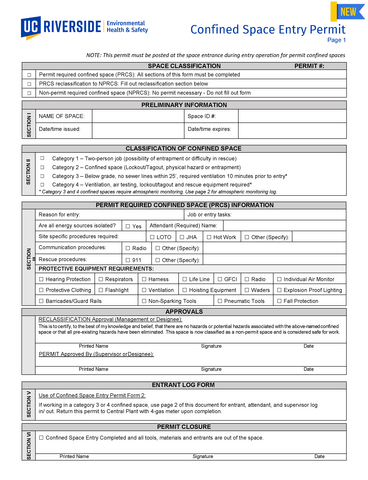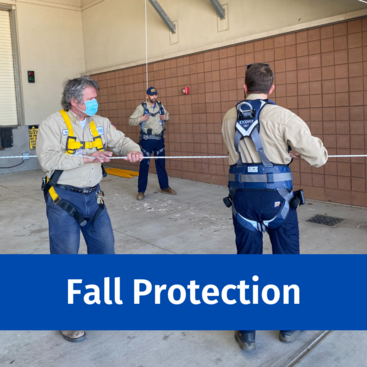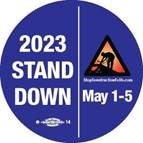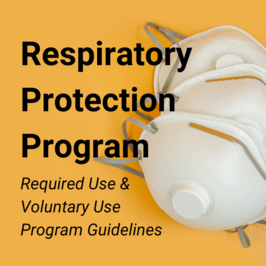What is Safety & Industrial Hygiene?
Safety & Industrial Hygiene is the practice of ensuring the general health and safety of the campus by supplying information, services, and equipment to help identify, evaluate, and control potentially harmful activities in the work and learning environment.
For more information, contact Safety or Industrial Hygiene or call (951) 827-5528.
Pre-Renovation/Demolition Hazardous Materials Building Survey Request
Abatement Project Notification
HOT WORK PERMIT REQUEST
General Safety
Safety program areas help you prevent injuries and illnesses while you are working.
-
Aerial Work Platforms
The Aerial Lift/Elevating Work Platform Safety Program works to manage the safe selection, procurement, use or and safe work practices, inspection, inventory tracking and record keeping of all university owned or rented Aerial Lift/Elevating Work Platform.
Aerial Lift Platform Written Program
Aerial Lift Equipment Inventory
Aerial Lift Pre-Use Inspection (online)
Aerial Lift Authorized Operators List
Aerial Lift Site Operation Hazard Assessment
Cal/OSHA Regulation 8 CCR 1670; 3637; 3638; 3639; 3640; 3642; 3645; 3646; 3647; 3648
-
Agriculture & Landscaping Safety
OSHA Landscape and Horticultural Safety and Health Topics
Cal/OSHA Tree Felling Safety Guide
Landscape Power Tool Safety Video
Stihl Chainsaw Safety Training Video Playlist
State Compensation Agriculture Safety Video Playlist
Western Center for Agricultural Health & Safety
U.S. Agricultural Safety & Health Centers Viseo Playlists
-
Confined Space
Confined Space Location Inventory
Confined Space Entry Permit - NEW
Central Plant 24/7 4-gas meter checkout now available from the control room!Utility Tunnel Safety Work Plan
4-Gas Meter (QRAE 3) Manual and Quick-Start Guide
Cal/OSHA Regulation 8 CCR 5157
016 - Tunnel Safety: Confined Space
-
Compressed Gas
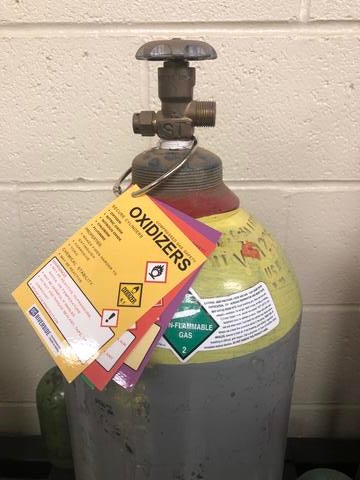
Stop by EH&S to pick up a set of safety cards for your lab or work area, today! The University requires the safe handling, use, and storage of compressed gas cylinders to protect employees and students from potential physical and health hazards associated with using compressed gases in laboratories or other locations that are part of the University.
Compressed Gas Quick Reference
***New Airgas Cryogenic Delivery Policy effective November 18, 2022***
On-demand webinar: Safe Gas Handling and Storage in Research Laboratories, Lab Manager
Lab Gas Handling Safety Infographic, Lab Manager
University laboratory (not UCR) liquid nitrogen explosion incident and alert
-
Cranes, Hoists, and Rigging
Large mobile cranes brought on campus require a permit from UCR Building & Safety be submitted via the Citizenserve portal. See detailed requirements here.
All manual and powered hoists used in labs, shops, loading areas, etc. need annual certification. All types of hoists should be registered with EH&S to ensure proper record keeping. USers of hoists must receive training and daily pre-use inspections are required. If you have hoists in you areas, please contact ehssafety@ucr.edu for assistance and training.
Overhead lifting and rigging requires rated hardware and components. All hardware must be rated for overhead lifting and purchased from a reputable rigging supplier. All rigging must be designed to include a 10:1 safety factor. Rigging systems should be designed and risk assessment completed prior to first lift. Systems designed for log-term or permanent use must have all screw in connection and turnbuckles secured with safety wire. All truss use on campus for lifting applications must be evaluated and approved by campus Safety Engineer. For assistance with rigging design and use, please contact ehssafety@ucr.edu for assistance.
- Dining Safety
-
Drone Safety Program
The Drone Safety Program contains information about how to use University drones legally and safely for research, educational, scientific, and business purposes.
-
Electrical Safety
The UCR Electrical Safety Program applies to all faculty, staff, and students at UC Riverside who may be using electrical appliances, plugging and unplugging equipment, replacing equipment fuses, and in the vicinity of electric systems, they may not directly use. Any UCR employees that perform work beyond simple plugging and unplugging, and those who use electrical equipment with a voltage over 208 volts must authorized qualified electrical workers prior to engaging in any electrical work. Supervisors must ensure anyone under their care has the experience, skill, training, and ability to perform safe electrical work before authorizing any electrical work above the hazard thresholds prescribed in the Basic Electrical Safety Program. Please contact the UCR Safety Engineer for assistance with any electrical safety questions or concerns.
UCR Basic Electrical Safety Written Program
Energized Electrical Guidance & Permit
Electrical Cord Inspection Checklist
Electrical Safety in the Lab, Lab Manager, IRA WAINLESS, B.CH.E., PE, CIH, March 3, 2021
Proper Application and Use of Power Strips (RPTS)
Use, Inspection, & Storage of Electrical Extension Cords
Cal/OSHA Regulation 8 CCR 3314
-
Event Safety
Outdoor Events
All outdoor events must be reviewed and approved by the Fire Marshal, Building Official, and EH&S Safety. If you are planning an outdoor event of any size please review the event safety checklist to determine what items need to be detailed in the permit request. Apply for an event permit with UCR Building & Safety on their website linked below. You will need to provide a map of the event and a detailed description explaining how many attendees you expect and what will be included (rides, food trucks, tables, tents, generators, fencing, etc.) Please submit the permit request as early as possible. Review averages 14-21 days and if there is not enough information in the request it can take even longer.
Link for the Event Checklist: https://pdc.ucr.edu/sites/default/files/2025-06/2025-revised-outdoor-event-checklist_updated-06-02-2025.pdf
Link to the application portal: https://citizenserve.com/ucr
Indoor Events
Please visit the UCR Reservable Spaces Website to start at this link: https://hub.ucr.edu/scheduling/reservable
If there are specific safety concerns for an indoor event please contact ehssafety@ucr.edu for assistance. Larger events may need approval and review by the Fire Marshal, the Building official, and EH&S Safety. Contact UCR Building & Safety for information. The UCR Building & Safety Website is linked here: https://pdc.ucr.edu/building-safety-division
-
Fall Protection
Fall Protection
Fall Protection involves eliminating fall hazards and safely stopping a person who does fall.
UC Riverside has a Fall Protection Program in place to help supervisors and employees:
- Identify work situations that require fall protection
- Implement and document Fall Protection Safety Plans
- Select and use appropriate fall protection systems
Fall protection is required wherever the potential exists to fall 4 feet or more in general industry activities, and 6 feet for construction activities.
Departments with employees working in these situations must follow the UC Riverside Fall Protection Program requirements.
If you have questions about how to implement the UCR fall protection program, choose equipment for purchase, or developing a safe work procedure for your work area please contact EH&S at ehs@ucr.edu or (951) 827-5528 for assistance.
View the UCR Fall Protection Program Page
- Identify work situations that require fall protection
-
Forklift Safety
EH&S has developed a forklift operator safety certification program and can provide forklift operator safety training for employees working in departments, at field stations and engaged in work/research operations that use these types of equipment.
No individual is permitted to operate a university-owned lift prior to successfully completing this certification training program, regardless of previous experience or certification. Trainees/operators must be at least 18 years of age and hold a valid driver’s license.
Forklift Safety Written Program
All departments that own and/or use forklifts must post the below rules posters in the assigned department buildings and all employees that use the equipment must be shown where to find the posters.
- Cal/OSHA Operating Rules for Industrial Trucks - English
- Cal/OSHA Operating Rules for Industrial Trucks - Spanish
Departments that own, lease, rent and/or otherwise operate forklifts and other types of industrial lift trucks must:
- Select and then purchase or rent appropriate equipment for job tasks based upon the work-environment and the completion of a job/task hazard analysis.
- Ensure personnel are properly trained, licensed and authorized to operate the specific type(s) of owned/rented equipment, in accordance with established campus guidelines. The department must post a list of trained and authorized operators in a conspicuous location.
- A familiarization training must be requested when ordering and conducted by the rental company for any new type of forklift and documented prior to use. Documentation must be sent to the UCR Safety Engineer to add to the employee's records.
- Ensure all operators are completing and documenting pre-use inspections and worksite safety assessments. Worksite safety assessments should be posted and accessible to all employees.
- Conduct required annual and frequent documented safety inspections and preventive maintenance of the equipment with a manufacturer certified technician vendor.
- Purchase and supply all required personal protective equipment (PPE) for persons trained and authorized to operate forklifts and industrial lift trucks.
- Assure operators adhere to specific safe-work practices whenever using these types of powered industrial equipment including use of personal protective equipment (PPE) as required.
- Approve Contractors/Vendors to use forklift/industrial lift truck equipment on their premises, and do not allow contractor/vendor personnel to use Department-owned equipment without express written permission from the UCR Safety Engineer. Note: Contractors/vendors must have proof of training and licensing to operate this equipment equal to or exceeding the established requirements for UCR personnel.
Pre-Use inspections are required prior to use every shift. Below is a link to an online inspection checklist and a paper copy checklist. The online version logs in a spreadsheet managed by EH&S. Paper copies should be scanned and stored in department files that can be accessed when requested by EH&S. Departments are responsible to make sure inspections are completed.
Online Pre-Use Inspection Checklist
Paper Pre-Use Inspection Checklist
Forklift Authorized Operators List
Regulations:
Cal/OSHA Regulation 8 CCR 3668
-
Hazard Communication
The Hazard Communication Program (HAZCOM) is designed to maintain a healthy work environment by increasing employee awareness about the hazards of the chemicals that they work with.
UCR Hazard Communication Written Program
Cal/OSHA Regulation 8 CCR 5194
-
Heat Illness Prevention
Southern California is a desert and it is important to remember that working outdoors during hot days can lead to heat illness. Water. Rest. Shade. Follow the link below to get more information about heat illness prevention at UCR.
UCR Outdoor and indoor Heat Illness Prevention information
Quick links:
- Heat Illness Training in UC Learning Center: UC Heat Illness
- UCR Hydration Stations Map
- How to Handle Heat Stress, Lab Manager, VINCE MCLEOD, CIH, May 4, 2020
- Cal/OSHA Outdoor Heat Illness Prevention
- Cal/OSHA Indoor Heat Illness Prevention
- Cal/OSHA Regulation Heat Illness Prevention Guidance
- Federal OSHA Occupational Heat Exposure
- Using the Heat Index: Guide for Employers (OSHA)
- Work Rest Guidelines: English | Spanish
- OSHA Heat Safety Tool for Android or Apple
- Infographic: Health Effects of Heat
-
Hot Work Program
The Hot Work Program details the process required to obtain and complete a hot work permit to perform hot work (welding, burning, grinding, and cutting) activities at the UC Riverside campus and facilities. These procedures have been established to prevent accidental fires, loss of life, injury from exposure to sparks, heat, or flames, and/or property loss. The hazards associated with hot work can be reduced through the implementation of an effective control program
Hot Work Designated Area Request
Cal/OSHA Regulation 8 CCR 6777
Tutorial:
-
Injury Illness and Prevention Program
Per California Code of Regulations, Title 8, Section 3203, we have incorporated a campus wide Injury and Illness Prevention Plan (IIPP) which describes specific requirements for program responsibility, compliance, communication, hazard assessment, accident/exposure investigations, hazard correction, training, and record keeping. This is incorporated in the IIPP campus policy, which includes specifics about responsibilities, implementation, and program elements.
Injury and Illness Prevention Plan online
Injury Illness Prevention Plan pdf
Cal/OSHA Regulation 8 CCR 3395
-
Janitorial Safety
Janitorial Safety Training Guide
developed by the Labor Occupational Health Program (LOHP) -
Ladder Safety
Visit the Ladder Safety Program page to learn more about the safe selection, procurement, use of and safe work practices, inspection, inventory tracking and record keeping of all University owned ladders. This program describes all aspects of ladder safety including a ladder safe-use policy, personnel accountability, hazard assessment and proper ladder selection, safe work practices, training requirements, and record keeping.
Weekly Safety Topics:
- Ladder Safety: Ladder Inspections
- Ladder Safety: Ladder Selection
- Ladder Safety: 3 Points of Contact
-
Lockout/Tagout
The purpose of this Lockout/Tagout Program is to ensure that their employees' health is protected from hazardous energies in the work environment.
Lockout/Tag Out Printable "RSS Procedures" Template use this template to create LOTO procedures for you work area.
Lockout/Tag Out Printable Complex Long Form Template
Cal/OSHA Regulation 8 CCR 3314
Federal OSHA Regulation 29 CFR 1910.147
-
Personal Protective Equiptment
Personal protective equipment controls hazards that cannot be eliminated through engineering and administrative controls*. PPE includes all clothing and accessories designed to protect against safety and health hazards.
PPE Hazard Assessment Certification
Slip-Resistant Shoe Program, Contact Pamela See, UCR program coordinator for assistance
Cal/OSHA Regulation 8 CCR 3380
-
Shop Safety
Shop Safety Program to manage the hazards associated with various shops and their work activities to comply with Cal-OSHA and other regulations concerning shops. Included are work activities conducted by temporary employees and graduate students performing research at field stations and remote research facilities.
UC Shop Safety Program & Manual
Shop Self-Inspection Checklist- Conduct a self-inspection every 6 months between EH&S visits.
Tool Specific Safety Training and information: https://www.powertoolinstitute.com/
Maker Spaces and Maker Equipment present unique challenges. If you have or are considering purchasing this type of equipment request a review from EH&S.
Cal/OSHA Regulation 8 CCR 3301; 3314; 4650; 5110
Federal OSHA Regulation 29 CFR 1910.147
-
Theater & Performing Arts Safety
The goal of the Theater & Performance Safety Program is to ensure that a safe, healthy environment shall be maintained at all times within all campus Theatre & Performing Arts departments and programs. This includes the control and minimization of all known and potential hazards associated within creative, artistic, and performance development.
UC Performing Arts Safety Manual
-
Vehicle Safety
Vehicle use by employees can pose a serious potential for injury if not operated in a safe manner. All vehicle use on campus must comply with local and state regulations. All operators must have a valid driver's license and be over 18 years of age to operate UCR owned vehicles. Special use vehicles such as ATVs, UTVs, or snowmobiles have additional requirements and must be registered with UCR Fleet Services and EH&S. Please review the specific vehicle information below.
Distracted Driver Avoidance Online Class
Motorized Carts Online Training
-
Supervisor Safety Resources
Supervisors are responsible for ensuring the safety of their direct reports. Supervisors should work with their employees to perform a job hazard analysis (JHA) to identify, analyze, and control hazards in their work areas. Having clear written procedures based on this type of analysis is key to avoiding accidents and injuries.
Job Hazard Analysis Training Videos - brief easy to understand video series on how to create JHAs.
Industrial Hygiene
Industrial hygiene activities involve the anticipation, recognition, evaluation and control of workplace hazards.
-
Asbestos
Asbestos is the name given to six minerals that occur naturally in the environment as bundles of fibers that can be separated into thin, durable threads for use in commercial and industrial applications. If products containing asbestos are disturbed, tiny asbestos fibers are released into the air. When asbestos fibers are breathed in, they may get trapped in the lungs and remain there for a long time. Over time, these fibers can accumulate and cause scarring and inflammation, which can affect breathing and lead to serious health problems. It is important for employees to follow proper work practices to minimize the potential for disturbing any presumed asbestos containing material (PACM) and potentially releasing asbestos fibers into the air.
Prior to any demolition or renovation project, be sure to submit a Pre-Renovation/Demolition Hazardous Materials Building Survey Request
Abatement Project Notification
Download UCR's Asbestos Management Plan
Annual Campus Asbestos Notification
Resources:
- Cal/OSHA Regulation 8 CCR 1529; 5208; 8358
- Federal OSHA Regulation 29 CFR 1910.1001; 1926.1101
- EPA Asbestos Website
- Asbestos FAQ
- Awareness Training
- For more information on these and other health effects of asbestos exposure, see the Agency for Toxic Substances and Disease Registry website.
-
Crystalline Silica Program
The purpose of the Crystalline Silica Program is to protect the UC Riverside campus community from health hazards associated with exposures to respirable dust that contains crystalline silica and ensure campus compliance with applicable health and safety regulations. To request a respirator, please email ehsih@ucr.edu.
UCR's Written Crystalline Silica Program
Cal/OSHA Table 1 Specified Exposure Control Methods
Cal/OSHA Regulation: 8 CCR 1532
-
Hearing Conservation
Hearing conservation programs strive to prevent initial occupational hearing loss, preserve and protect remaining hearing, and equip workers with the knowledge and hearing protection devices necessary to safeguard themselves. Employees who are routinely exposed to high levels of workplace noise must participate in the Hearing Conservation Program. At UCR, this level is 85 dB(A) averaged out over an 8-hour workday. Those affected may include, but are not limited to, personnel in:
- Machine shops
- Maintenance and utilities
- Landscape
- Carpentry and machine shops
- Housing and dining services facilities
- Engineering
- Vivaria
Testing for Hearing Conservation is conducted annually in December, contact EH&S at (951) 827-5528 for details
UC Riverside Hearing Conservation Program
OSHA Hearing Conservation Standard
Occupational exposure to noise: evaluation, prevention and control (WHO)
Cal/OSHA Regulation 8 CCR 5097 5095
-
Fume Hoods
Chemical Fume Hoods capture and remove contaminants to prevent overexposure to personnel within the lab. When properly used, a well-designed hood in a ventilated room will protect you (a trained laboratory worker) from most airborne exposures to hazardous laboratory chemicals.
2020 Fume Hood Program Document
Guide to Health, Safety, and Environmental Responsibilities for Researchers
Cal/OSHA Regulation 8 CCR 5154.1
-
Indoor Air Quality
The quality of indoor air inside offices, schools, and other workplaces is important not only for workers' comfort but also for their health. Poor indoor air quality (IAQ) has been tied to symptoms like headaches, fatigue, trouble concentrating, and irritation of the eyes, nose, throat and lungs. The General Duty Clause of the OSH Act (the law that created OSHA) requires employers to provide workers with a safe workplace that does not have any known hazards that cause or are likely to cause death or serious injury.
California Indoor Air Quality State Plan (OSHA)
-
Lead
The University has measures in place to inform you of, and protect you from, the dangers of lead.
Prior to any demolition or renovation project, be sure to submit a Pre-Renovation/Demolition Hazardous Materials Building Survey Request
-
Respiratory Protection
Respiratory Protection Program
EH&S evaluates workplaces for possible airborne hazards and recommends ways to reduce these hazards when found. When appropriate, EH&S will fit campus workers with respirators and provide annual training on their proper use. EH&S evaluates a person's ability to safely wear a respirator prior to a respirator being issued. For more information visit the Respiratory Protection Page.
Do not buy, borrow or wear a respirator without contacting EH&S first!
-
Substance Specific Program
The purpose of the UCR Substance Specific program is to minimize or control risk of occupational exposure to the hazardous and regulated substances by:
• Conducting exposure assessments and monitoring
• Establishing safe handling practices and controls to minimize exposure
• Providing health hazard information and training
• Maintaining an employee medical surveillance program
-
Water Intrusion & Mold
Mold is fungi that is found everywhere – both indoors and outdoors all year round. The terms fungi and mold are often used interchangeably, but mold is actually a type of fungi. Concern about indoor exposure to mold has increased along with public awareness that exposure to mold can cause a variety of adverse health effects. There are many thousands of species of mold and most if not all of the mold found indoors comes from outdoor sources. It seems likely to grow and become a problem only when there is water damage, high humidity, or dampness.
-
Wild Fire Smoke Protection
The University has measures in place to inform you of, and protect you from, the dangers of inhaling wildfire smoke.
Wildfire Smoke Protection Training
Cal/OSHA Regulation 8CCR 5141.1 | View in Spanish
Mandatory Training Requirements (Appendix B) -
Workplace Exposure Assessments
The Workplace Exposure Assessment Program is established at UCR in order to evaluate potential personal exposures to hazardous substances. The program consists of a variety of activities implemented to evaluate a person’s exposure including observation of job routine, evaluation of work place control measures and environmental sampling. Several types of sampling are performed by Environmental Health and Safety (EH&S) depending on the nature of the chemical hazard, the frequency of chemical use and the way the chemical is handled.
Chemical exposure monitoring is often initiated by EH&S and can also be provided upon request. Some of the typical chemicals, which are monitored at UCR, include:
-
Asbestos
-
Lead particulate (Lead Based Paint)
-
Formaldehyde
-
Hazardous laboratory chemicals
-
Solvent based materials and cleaning products
-
Chemical carcinogens or extremely toxic substances
Cal/OSHA Regulation 8 CCR 5204
-
